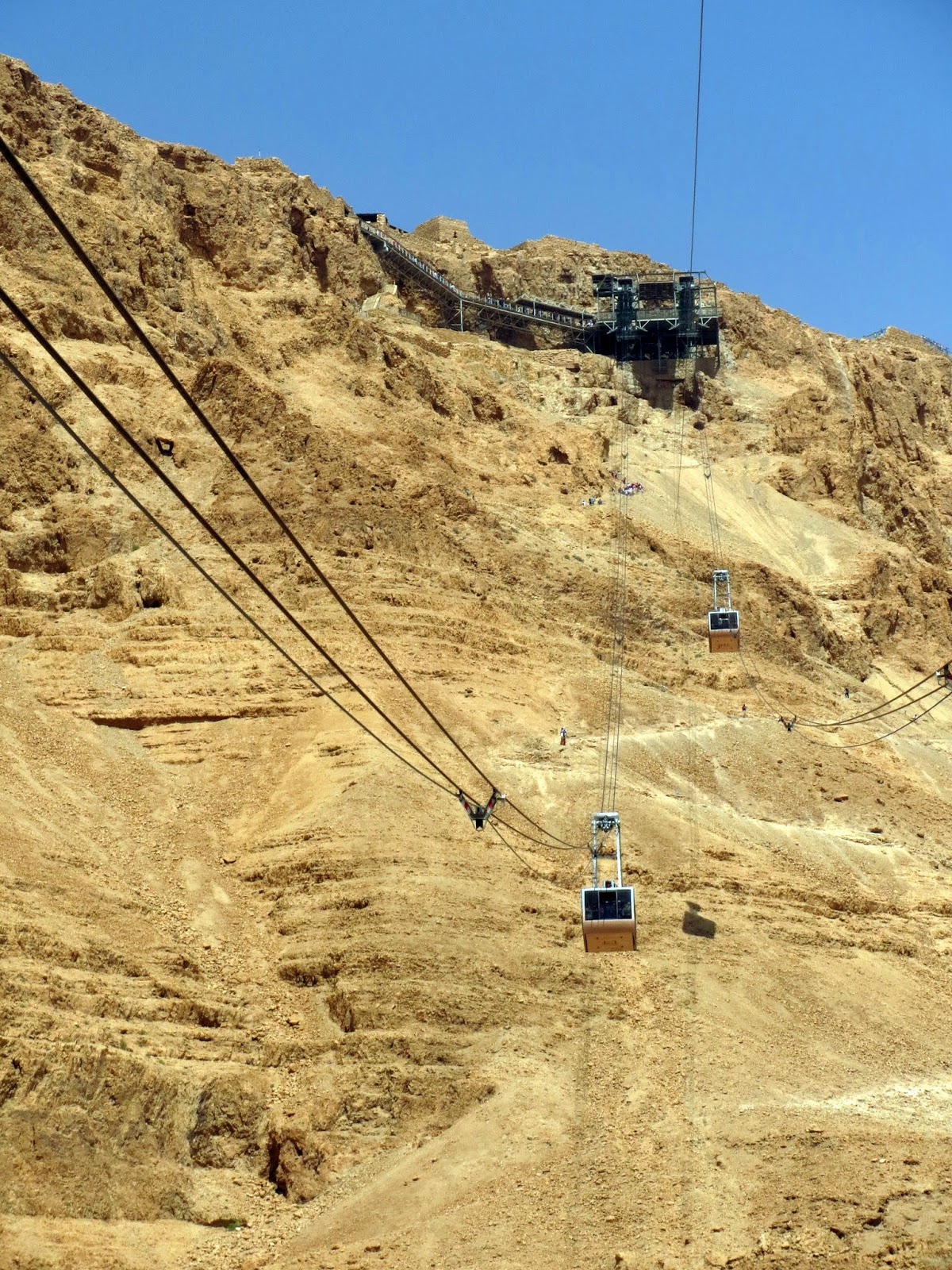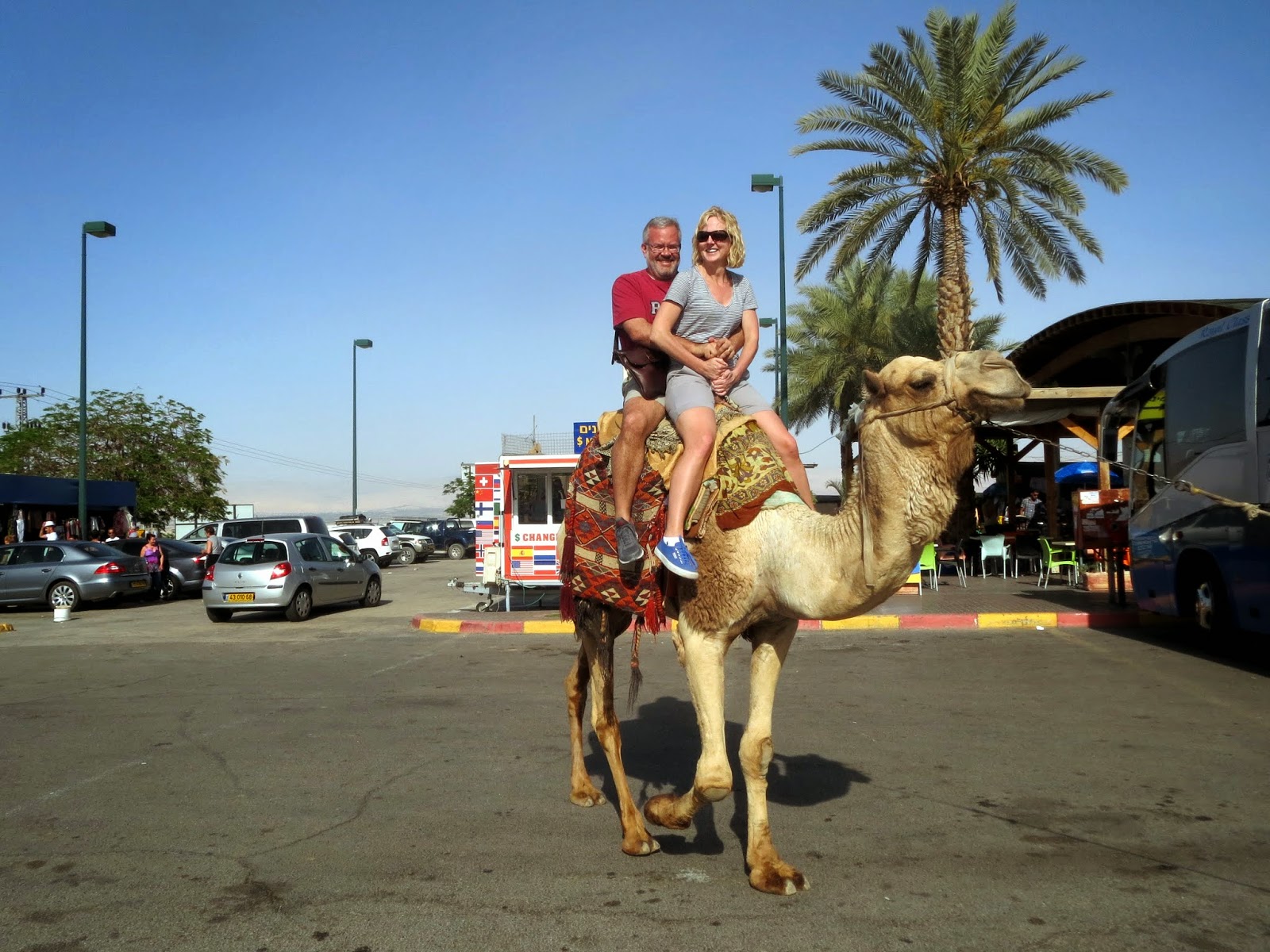Enough of the city. It's time to go to the desert!
We spent a day traveling east to the Dead Sea through the Judean Desert. Along the way, we
visited Masada and Ein Gedi. Of course, it was the hottest days of our trip (around 40C, or 100F)
We also drove past Qumran, which is where the Dead Sea Scrolls were discovered by a Bedouin shepherd in 1947. But we didn't stop - not enough time that day - although we saw the cave from the road. No pictures.
Let's start with Masada. Masada is an isolated mountain fortress, in the Judean Desert, 1300 ft. above the Dead Sea. It was originally built in 1st or 2nd Century B.C., but then enlarged and reinforced by Herod the Great around 30-37 A.D. after he gained control of his kingdom. Herod felt threatened both internally by the Jews of his kingdom, and externally by Cleopatra, who wanted Judaea as part of her Egyptian kingdom
It was only discovered in 1842, and no excavation works began until 1963! Because of it's remoteness and climate, it was essentially untouched by humans for almost 1900 years
Herod took what was a "typical" fortress & built two large palaces. Along with kitchens, bathhouses, an elaborate storeroom, barracks & housing for the army & slaves, a pool, etc., etc. etc.... All on top of a mountain in the desert in 30 B.C.!!!
Legend says that Herod was a genius, and a madman, for various reasons. Masada is a great example of that
Upon Herod's death, Judea came under direct rule of the Roman empire. So Masada passed into the Roman's hands. But in 66 A.D., it was captured during the First Revolt by the Jews of the Zealot sect.
The Jews held Masada throughout the revolt, and many Jews settled there, particularly after the fall of Jerusalem and the destruction of the Second Temple in 70 A.D.
They held out for 3 years. According to historical accounts by 1st century historian Flavius Josephus, the Romans (numbering as high as 10,000 men) surrounded the mountain with a ring of 8 camps. They then constructed a ramp of thousands of tons of stones and earth, and a tower. And in the spring of 74 CE, they moved a battering ram up the ramp and breached the wall of the fortress.
Rather than submit to the Romans, the Jews chose to commit suicide. "Masada will not fall again" is part of the swearing-in oath of the modern Israeli army.
Tilework in the bathhouses are still visible.
Small stools in one of the sitting rooms
Amazing how you can picture the rooms
See the plaster on the bottom portion of the wall?
These birds were everywhere! Very aggressive. I was told that they were a type of grackle - a Tristram Grackle, noted for the orange feathers
Here's a view of the Hanging Palace, part of the Northern Palace complex. This was Herod's private residence, actually built on 3 levels.
From the top, you can see markings from where the Roman base camps were established during the Roman siege
A bath tub
More tiles and baths
The thermal baths. The columns were used to raise the floor, so hot air could circulate underneath and heat the room
This room was the synagogue, thought to one of the oldest in the world.
Next, we traveled to Ein Gedi. It's famous for being an oasis in the Judean desert. There are several springs, tropical vegetation, wildlife, and was declared a nature reserve in 1971
Ein Gedi is mentioned in the Bible for it's beauty (Song of Songs 1-14), and as a refuge for King David, who was fleeing from King Saul (King Saul seeks him "even upon the most craggy rocks, which are accessible only to wild goats" (1 Samuel 24:3).
Caves in the rocks! Part of the Nahal David caves.
These are rock hyrax. They were everywhere, and commonly live in the rocks of the Middle East and Africa. It's closest living relative is the elephant (!), due to the fact that the male's "goods" are located inside their abdomen..
Close-up of baby hyrax.
An ibex family in the Acacia Tree. The longer you look, the more you will see.
And now to the beach! The Dead Sea lies 1/2 in Israel, 1/2 in Jordan. It is also 1350 ft. below sea level, making it the lowest place on earth. The water is approximately 30% solids, primarily salts - 9 times saltier than the ocean. So you can't swim in it and you would get incredibly sick (and most likely die) if you drank any of the water.
But you can float. In fact, it's impossible not to float, because the water is dense, making you more buoyant.
The water and the climate are also believed to be incredibly therapeutic. Everything from arthritis, skin conditions, stress, fluid retention, respiratory illnesses, wrinkles. You name it!
But first things first. You have to use mud.
Israeli military are everywhere!
It was a crazy experience. No problem floating, as you can see. It was really warm, and kind of slippery. You have to wear shows or flip-flops because the salt crystals on the bottom can cut your feet.
Afterwards, I have to say that my skin was SO SOFT! As soft as a baby's bottom. I liked it
Finally, meet our friend.
I wanted a camel picture. And Tamar (our tour guide) found me one for a short (very short) ride. But Tamar insisted that Pat also get on the camel. If I had asked him, no way would he get on a camel! Under any circumstance!!!!
But he couldn't say no to Tamar (she is ex-Israeli military, after all. I wouldn't mess with her either).
So here we go!!!








































Wow ! You saw the bible come to life. Shouldn't be a surprise that some of my favorite pictures were of the creatures. The camel ride looked like fun.
ReplyDeleteWhat a place. did you try any camel steaks ?
ReplyDelete